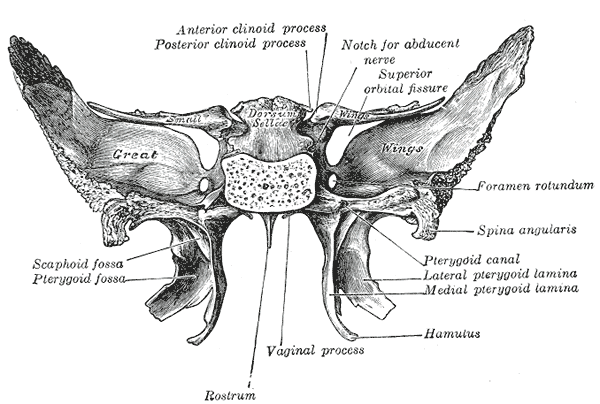[2]
Kasai E, Kondo S, Kasai K. Morphological variation in the anterior cranial fossa. Clinical and experimental dental research. 2019 Apr:5(2):136-144. doi: 10.1002/cre2.163. Epub 2019 Jan 31
[PubMed PMID: 31049216]
[3]
Laleva L, Spiriev T, Dallan I, Prats-Galino A, Catapano G, Nakov V, de Notaris M. Pure Endoscopic Lateral Orbitotomy Approach to the Cavernous Sinus, Posterior, and Infratemporal Fossae: Anatomic Study. Journal of neurological surgery. Part B, Skull base. 2019 Jun:80(3):295-305. doi: 10.1055/s-0038-1669937. Epub 2018 Sep 6
[PubMed PMID: 31143574]
[4]
Kandyba DV, Babichev KN, Stanishevskiy AV, Abramyan AA, Svistov DV. Dural arteriovenous fistula in the sphenoid bone lesser wing region: Endovascular adjuvant techniques of treatment and literature review. Interventional neuroradiology : journal of peritherapeutic neuroradiology, surgical procedures and related neurosciences. 2018 Oct:24(5):559-566. doi: 10.1177/1591019918777233. Epub 2018 May 31
[PubMed PMID: 29848145]
[5]
Natsis K, Piagkou M, Lazaridis N, Totlis T, Anastasopoulos N, Constantinidis J. Incidence and morphometry of sellar bridges and related foramina in dry skulls: Their significance in middle cranial fossa surgery. Journal of cranio-maxillo-facial surgery : official publication of the European Association for Cranio-Maxillo-Facial Surgery. 2018 Apr:46(4):635-644. doi: 10.1016/j.jcms.2018.01.008. Epub 2018 Feb 10
[PubMed PMID: 29534911]
[6]
De Rosa A, Pineda J, Cavallo LM, Di Somma A, Romano A, Topczewski TE, Somma T, Solari D, Enseñat J, Cappabianca P, Prats-Galino A. Endoscopic endo- and extra-orbital corridors for spheno-orbital region: anatomic study with illustrative case. Acta neurochirurgica. 2019 Aug:161(8):1633-1646. doi: 10.1007/s00701-019-03939-9. Epub 2019 Jun 7
[PubMed PMID: 31175456]
Level 3 (low-level) evidence
[7]
Yamamoto M, Ho Cho K, Murakami G, Abe S, Rodríguez-Vázquez JF. Early Fetal Development of the Otic and Pterygopalatine Ganglia with Special Reference to the Topographical Relationship with the Developing Sphenoid Bone. Anatomical record (Hoboken, N.J. : 2007). 2018 Aug:301(8):1442-1453. doi: 10.1002/ar.23833. Epub 2018 May 4
[PubMed PMID: 29669195]
[9]
Antonopoulou M, Iatrou I, Paraschos A, Anagnostopoulou S. Variations of the attachment of the superior head of human lateral pterygoid muscle. Journal of cranio-maxillo-facial surgery : official publication of the European Association for Cranio-Maxillo-Facial Surgery. 2013 Sep:41(6):e91-7. doi: 10.1016/j.jcms.2012.11.021. Epub 2012 Dec 20
[PubMed PMID: 23265808]
[10]
Dolapsakis C, Kranidioti E, Katsila S, Samarkos M. Cavernous sinus thrombosis due to ipsilateral sphenoid sinusitis. BMJ case reports. 2019 Jan 29:12(1):. doi: 10.1136/bcr-2018-227302. Epub 2019 Jan 29
[PubMed PMID: 30700458]
Level 3 (low-level) evidence
[11]
Naran S, Swanson JW, Ligh CA, Shubinets V, Taylor JA, Bartlett SP. Sphenoid Dysplasia in Neurofibromatosis: Patterns of Presentation and Outcomes of Treatment. Plastic and reconstructive surgery. 2018 Oct:142(4):518e-526e. doi: 10.1097/PRS.0000000000004779. Epub
[PubMed PMID: 30020238]

